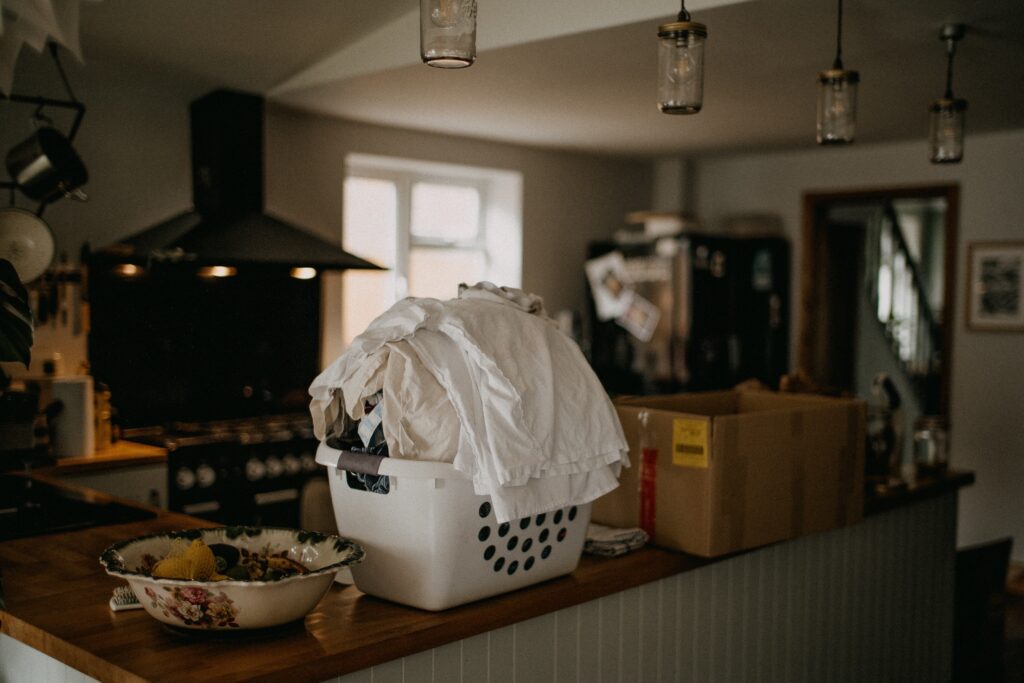Do Washing Machines Belong in Kitchens? Many Brits Say “Yes.”

Excerpted from Silent but Deadly: The Underlying Cultural Patterns of Everyday Behaviour by Kirsten Bell. Caw Press, 2022. All rights reserved.
After my husband and I moved from Canada to London, there was one question we repeatedly had cause to ask ourselves as we were looking for a place to live: Why do Brits insist on putting their washing machines in their kitchens?
The complaint is a common one among expats living in the U.K. As Tanya Vincent, an Australian architect living in London, has observed: “The washing machine in the kitchen is a convention so entrenched that it is barely questioned. Granted, British houses don’t all have the luxury of a utility room, but what’s often required is a more realistic allocation of space.” In the end, putting it down to a quirk of British life, we resigned ourselves to the inevitability of purchasing a house with a washing machine in the kitchen—then quickly moved it to the downstairs bathroom.
In 2017, television personality Kirstie Allsopp, who hosts the popular real estate reality show Location, Location, Location, inadvertently set off a Twitter storm when she weighed in on the issue of washing machines in kitchens in response to a tweet by British journalist Jim Waterson. Waterson had observed: “Americans in our office are always confused by the British habit of putting washing machines in kitchens and view this as disgusting.”
Allsopp responded, tongue half-in-cheek, “It is disgusting, my life’s work is in part dedicated to getting washing machines out of the kitchen.” The reaction was immediate and irate, with British tweeters demanding to know where washing machines should be put if a homeowner has no utility room. Allsopp’s reply, “Bathroom, hall cupboard, airing cupboard,” merely inflamed the Twitter mob. Out of patience, Allsopp noted in her closing salvo, “Look you bunch of total fuck wits, IF POSSIBLE have a washing machine out of the kitchen frees up space, if not possible no big deal.”
For many Brits, Allsopp’s reflections on washing machines had revealed her to be completely out of touch with the lives of regular British people. “A posh flat, a holiday cottage, a mansion staffed by six … welcome to the wonky world of Kirstie Allsnob” was the title of a snarky article in the British tabloid The Sun by the radio presenter Julia Hartley-Brewer. YouGov, the influential British survey website, rapidly developed a poll on the topic. They surveyed 3,641 adults, and 67 percent of respondents indicated that the kitchen was indeed the right place to have the washing machine. British people, it seemed, had definitively spoken: Washing machines belong in kitchens.
Brits will generally tell you that washing machines are placed in kitchens purely because of utilitarian considerations: constraints on plumbing and space issues. However, to most foreigners, this explanation seems inadequate. While it’s true the square footage of the average-size home is markedly larger in North America and Australia than in the U.K., even in cities where space is at a premium, architects still find room for laundry areas. Of course, housing is typically newer in these countries, but washing machines tend to be placed in kitchens in the U.K. regardless of the property’s age. Moreover, even in properties that have been extensively renovated, with loft extensions and extra bathrooms added, washing machines still tend to be placed in kitchens.
This is probably what foreigners find most bewildering about British attitudes to washing machines: Even when people have the option to place their washing machine elsewhere, they seem to prefer the kitchen. As the U.S. reporter Corinne Purtill notes of Brits’ seeming indifference to installing dryers:
To an American, this is baffling. Britain is not sunny Italy, where I’m guessing you can simply fling washed clothes onto the terrazza in the morning, and they’re crisp by the end of your post-prandial nap. Britain is damp. It’s wet all the time. It rained every single day for a month when I first moved there—and that was in the summer. It is a place crying out for the convenience of warm, dry clothes.
The damp climate means that people are forced to use a drying rack, thus taking up precious real estate in the kitchen or living room. Alternatively, you can purchase a combined washer/dryer in place of a washing machine, which is what our house came equipped with. While this sounds like a viable solution to the problem, this godawful device takes a tiny volume of clothes, washes them badly, and dries them until they literally squeak but are not dry enough to, you know, actually fold up and put away. Oh, and the whole process takes about five hours.
How and where people do their laundry may seem trivial, but home architecture can reveal a lot about a society’s cultural values. As the anthropologist Irene Cieraad notes:
The reasons for the characteristics of our domestic surroundings seem self-evident, preventing us from asking such obvious questions as: Why do we cover our interior walls and windows? Why is it that we seldom put a bed in the kitchen? Why store dirty laundry in hidden corners?
According to the human geographer Louise Johnson, kitchens in most Western countries were typically located at the back of the house before the 1950s, reflecting their lower status as “spaces dealing with food, dirt, women, and servants.” But things changed dramatically with the rise of open-plan living. As the British design historian Judy Attfield notes, modernist architects saw open plan as a means of embedding modern values in the house’s structure itself. Thus, architects prioritized ease of use and maintenance, rejected traditional styles and unnecessary ornamentation in favor of a minimalist aesthetic, and eliminated walls to create a more “democratic” multipurpose living space. They also relocated the kitchen from the back of the house to become the literal and symbolic core of the home.
Although bright, open-plan houses became standard across much of the Western world in the post-war period, they weren’t embraced in the U.K. in quite the same way. The history of New Harlow, a post–World War II planned community, attests to this ambivalence toward modernist design. According to Attfield, the architects of New Harlow designed the homes to include open-plan living spaces instead of the usual two reception rooms. They saw this as democratizing the space by dissolving the “cold formality” of the front room and the “unquestioned traditional social hierarchy” on which it rested.
The tenants, however, hated it. The disappearance of the wall separating the front room from the back meant that there was no longer a physical separation between the parlor—typically kept tidy and used as a space to receive guests—from the more private, everyday activities in the back of the house.
If, as the anthropologist Kate Fox has suggested, Englishness is characterized by an almost pathological need for privacy, the disappearance of the front room was no minor loss. Tenants reacted to this attempt to kill off the parlor by trying to re-create it via curtains, furniture, and, in some cases, illegal structural alterations to add and reposition walls. The architects, in their turn, complained that “open-plan houses are being closed up again, light rooms are darkened, and a feeling of spaciousness is reduced to cosy clutter.”
Over time, open-plan living has become more normalized in the U.K. For instance, it’s now common for the wall between the two reception rooms to be removed, at least partially, although they’re still generally listed as separate rooms in real estate listings. However, the view of kitchens as exclusively service spaces seems to have lingered. Only recently have people started to think of kitchens as multipurpose living spaces.
Once the kitchen is no longer considered merely a service room, it changes how people use the space, including how they determine what activities are and aren’t appropriate. This is why washing machines in kitchens seem odd to most foreigners. Living spaces are areas where we relax, socialize, cook, and eat (ideally, with the cook able to socialize while preparing food). They are not the appropriate location to perform ablutions on our bodies or clothes.
It’s also why this location occasionally attracts disgust among those unfamiliar with British norms. When a kitchen is a living space, activities dealing with the body’s effluvia suddenly become matter out of place—or, to use the terminology of the anthropologist Mary Douglas, “dirt.” As Douglas notes in Purity and Danger: “Shoes are not dirty in themselves, but it is dirty to place them on the dining-table; food is not dirty in itself, but it is dirty to leave cooking utensils in the bedroom, or food bespattered on clothing … and so on.”
Because conceptions of dirt rely on how spaces are classified, reclassifying the space inevitably leads to a reclassification of what is dirty. This comes across strongly in a response Allsopp made to a tweeter demanding to know why washing machines in the kitchen were “disgusting.” In her words, “Why does anyone want to mix poo, pee, & period with food unless they have to?”
In sum, although British people will repeatedly tell you that washing machines, of necessity, are located in kitchens, they are lying—albeit mostly to themselves. This doesn’t mean that washing machines in kitchens are disgusting or unhygienic; instead, the unquestioned practice of placing them in kitchens reflects cultural ideals embedded in British houses, including notions of public and private space that have only recently shifted.
So, the next time you hear a British person moaning about their washing, let them know that a brighter (and drier) world is possible. To quote Purtill, “There are so many intractable problems humanity has yet to solve. … Drying clothes is not one of them. We’ve got this one, people! … You have nothing to lose but your damp.”
This excerpt has been lightly edited for style, clarity, and length.




























